Exploiting Sentinel-5P TROPOMI and Ground Sensor Data for the Detection of Volcanic SO2 Plumes and Activity in 2018–2021 at Stromboli, Italy
Abstract
:1. Introduction
- (1)
- Discuss and address the technical issues involved in TROPOMI SO2 data extraction, filtering by quality, outlier removal and time series generation to monitor small-size Strombolian volcanoes. To this scope, TROPOMI SO2 data processing is based on purposely adapted Python scripts;
- (2)
- Demonstrate a methodological and practical workflow for time series analysis enabling the spatio-temporal investigation of the key parameter of SO2 column density and its trend and variations, in order to better understand the activity of the volcano during and in between different eruptions. The demonstration is run with regard to events that occurred in 2018–2021 and also encompasses integration with ground data from permanent monitoring networks deployed across the volcano edifice, as well as contextual Sentinel-2 multispectral and Suomi NPP VIIRS observations.
2. Study Area and Recent Events
3. Materials and Methods
3.1. Sentinel-5P TROPOMI SO2 Data
3.2. Python Algorithm and Data Analysis
3.3. Ground-Based Sensor Data
4. Results and Discussion
4.1. Spatial Averaging and Ratioing
4.2. Integrated Analysis with Sentinel-2 Observations
4.3. Conditional VCDs for Three Volcanic Scenarios
4.4. Interactions between the Plumes of Stromboli and Mount Etna
4.5. Time Lapse of the 2019–2021 Eruptions
- The period of activity that started on 3 July 2019 with a paroxysm (Figure 7);
- A further paroxysm that occurred on 28 August 2019 (Figure 8), followed by two new bursts of slightly lower intensity between 29 and 30 August 2019:
- The major explosions that occurred on 13 August 2020 (Figure 9);
- A more recent period of activity that started on 19 May 2021 and lasted for several days (Figure 10).
5. Conclusions
Author Contributions
Funding
Institutional Review Board Statement
Informed Consent Statement
Data Availability Statement
Acknowledgments
Conflicts of Interest
References
- Inguaggiato, S.; Vita, F.; Rouwet, D.; Bobrowski, N.; Morici, S.; Sollami, A. Geochemical evidence of the renewal of volcanic activity inferred from CO2 soil and SO2 plume fluxes: The 2007 Stromboli eruption (Italy). Bull. Volcanol. 2011, 73, 443–456. [Google Scholar] [CrossRef]
- Olmos, R.; Barrancos, J.; Ivera, C.R.; Barahona, F.; López, D.L.; Henriquez, B.; Hernández, A.; Benitez, E.; Hernández, P.A.; Pérez, N.M.; et al. Anomalous emissions of SO2 during the recent eruption of Santa Ana volcano, El Salvador, Central America. Pure Appl. Geophys. 2007, 164, 2489–2506. [Google Scholar] [CrossRef]
- Werner, C.A.; Doukas, M.P.; Kelly, P.J. Gas emissions from failed and actual eruptions from Cook Inlet Volcanoes, Alaska, 1989–2006. Bull. Volcanol. 2011, 73, 155–173. [Google Scholar] [CrossRef]
- Aiuppa, A.; Giudice, G.; Gurrieri, S.; Liuzzo, M.; Burton, M.; Caltabiano, T.; McGonigle, A.J.S.; Salerno, G.; Shinohara, H.; Valenza, M. Total volatile flux from Mount Etna. Geophys. Res. Lett. 2008, 35, 24302. [Google Scholar] [CrossRef]
- Queißer, M.; Burton, M.; Kazahaya, R. Insights into geological processes with CO2 remote sensing—A review of technology and applications. Earth-Sci. Rev. 2019, 188, 389–426. [Google Scholar] [CrossRef]
- Shinohara, H. Excess degassing from volcanoes and its role on eruptive and intrusive activity. Rev. Geophys. 2008, 46, 4005. [Google Scholar] [CrossRef] [Green Version]
- Wallace, P.J. Volcanic SO2 emissions and the abundance and distribution of exsolved gas in magma bodies. J. Volcanol. Geotherm. Res. 2001, 108, 85–106. [Google Scholar] [CrossRef]
- Levelt, P.F.; Van Den Oord, G.H.J.; Dobber, M.R.; Mälkki, A.; Visser, H.; De Vries, J.; Stammes, P.; Lundell, J.O.V.; Saari, H. The ozone monitoring instrument. IEEE Trans. Geosci. Remote Sens. 2006, 44, 1093–1100. [Google Scholar] [CrossRef]
- Clarisse, L.; Hurtmans, D.; Clerbaux, C.; Hadji-Lazaro, J.; Ngadi, Y.; Coheur, P.F. Retrieval of sulphur dioxide from the Infrared Atmospheric Sounding Interferometer (IASI). Atmos. Meas. Tech. 2012, 5, 581–594. [Google Scholar] [CrossRef] [Green Version]
- Clerbaux, C.; Boynard, A.; Clarisse, L.; George, M.; Hadji-Lazaro, J.; Herbin, H.; Hurtmans, D.; Pommier, M.; Razavi, A.; Turquety, S.; et al. Monitoring of atmospheric composition using the thermal infrared IASI/MetOp sounder. Atmos. Chem. Phys. 2009, 9, 6041–6054. [Google Scholar] [CrossRef] [Green Version]
- Theys, N.; Hedelt, P.; De Smedt, I.; Lerot, C.; Yu, H.; Vlietinck, J.; Pedergnana, M.; Arellano, S.; Galle, B.; Fernandez, D.; et al. Global monitoring of volcanic SO2 degassing with unprecedented resolution from TROPOMI onboard Sentinel-5 Precursor. Sci. Rep. 2019, 9, 2643. [Google Scholar] [CrossRef] [PubMed]
- Queißer, M.; Burton, M.; Theys, N.; Pardini, F.; Salerno, G.; Caltabiano, T.; Varnam, M.; Esse, B.; Kazahaya, R. TROPOMI enables high resolution SO2 flux observations from Mt. Etna, Italy, and beyond. Sci. Rep. 2019, 9, 957. [Google Scholar] [CrossRef]
- Andres, R.J.; Kasgnoc, A.D. A time-averaged inventory of subaerial volcanic sulfur emissions. J. Geophys. Res. Atmos. 1998, 103, 25251–25261. [Google Scholar] [CrossRef]
- INGV Rete Automatica FLAME di Scanner UV Sullo Stromboli. Available online: http://sowebapp.ct.ingv.it/oldweb/stromboli/Flames.htm (accessed on 5 August 2021).
- LGS Stromboli Real-Time Monitoring: ROC station. Available online: http://193.206.127.20/realtime/roc.php (accessed on 5 August 2021).
- Barrière, J.; D’Oreye, N.; Oth, A.; Theys, N.; Mashagiro, N.; Subira, J.; Kervyn, F.; Smets, B. Seismicity and outgassing dynamics of Nyiragongo volcano. Earth Planet. Sci. Lett. 2019, 528, 115821. [Google Scholar] [CrossRef]
- Burton, M.; Hayer, C.; Miller, C.; Christenson, B. Insights into the 9 December 2019 eruption of Whakaari/White Island from analysis of TROPOMI SO2 imagery. Sci. Adv. 2021, 7, eabg1218. [Google Scholar] [CrossRef] [PubMed]
- Fioletov, V.; Mclinden, C.A.; Griffin, D.; Theys, N.; Loyola, D.G.; Hedelt, P.; Krotkov, N.A.; Li, C. Anthropogenic and volcanic point source SO2 emissions derived from TROPOMI on board Sentinel-5 Precursor: First results. Atmos. Chem. Phys. 2020, 20, 5591–5607. [Google Scholar] [CrossRef]
- Hedelt, P.; Efremenko, D.S.; Loyola, D.G.; Spurr, R.; Clarisse, L. Sulfur dioxide layer height retrieval from Sentinel-5 Precursor/TROPOMI using FP_ILM. Atmos. Meas. Tech. 2019, 12, 5503–5517. [Google Scholar] [CrossRef] [Green Version]
- Hyman, D.M.; Pavolonis, M.J. Probabilistic retrieval of volcanic SO2 layer height and partial column density using the Cross-track Infrared Sounder (CrIS). Atmos. Meas. Tech. 2020, 13, 5891–5921. [Google Scholar] [CrossRef]
- Kampouri, A.; Amiridis, V.; Solomos, S.; Gialitaki, A.; Marinou, E.; Spyrou, C.; Georgoulias, A.K.; Akritidis, D.; Papagiannopoulos, N.; Mona, L.; et al. Investigation of volcanic emissions in the mediterranean: “the Etna–Antikythera connection”. Atmosphere 2021, 12, 40. [Google Scholar] [CrossRef]
- Liu, E.J.; Aiuppa, A.; Alan, A.; Arellano, S.; Bitetto, M.; Bobrowski, N.; Carn, S.; Clarke, R.; Corrales, E.; De Moor, J.M.; et al. Aerial strategies advance volcanic gas measurements at inaccessible, strongly degassing volcanoes. Sci. Adv. 2020, 6, abb9103. [Google Scholar] [CrossRef]
- Theys, N.; De Smedt, I.; Yu, H.; Danckaert, T.; Van Gent, J.; Hörmann, C.; Wagner, T.; Hedelt, P.; Bauer, H.; Romahn, F.; et al. Sulfur dioxide retrievals from TROPOMI onboard Sentinel-5 Precursor: Algorithm theoretical basis. Atmos. Meas. Tech. 2017, 10, 119–153. [Google Scholar] [CrossRef] [Green Version]
- Di Traglia, F.; Calvari, S.; D’Auria, L.; Nolesini, T.; Bonaccorso, A.; Fornaciai, A.; Esposito, A.; Cristaldi, A.; Favalli, M.; Casagli, N. The 2014 effusive eruption at Stromboli: New insights from in situ and remote-sensing measurements. Remote Sens. 2018, 10, 2035. [Google Scholar] [CrossRef] [Green Version]
- Inguaggiato, S.; Vita, F.; Cangemi, M.; Calderone, L. Increasing summit degassing at the stromboli volcano and relationships with volcanic activity (2016–2018). Geoscience 2019, 9, 176. [Google Scholar] [CrossRef] [Green Version]
- Turchi, A.; di Traglia, F.; Luti, T.; Olori, D.; Zetti, I.; Fanti, R. Environmental aftermath of the 2019 Stromboli eruption. Remote Sens. 2020, 12, 994. [Google Scholar] [CrossRef] [Green Version]
- BBC Stromboli: One Dead as Volcano Erupts on Italian Island. BBC News, 3 July 2019. Available online: https://www.bbc.com/news/world-europe-48857422(accessed on 6 July 2021).
- Bevilacqua, A.; Bertagnini, A.; Pompilio, M.; Landi, P.; Del Carlo, P.; Di Roberto, A.; Aspinall, W.; Neri, A. Major explosions and paroxysms at Stromboli (Italy): A new historical catalog and temporal models of occurrence with uncertainty quantification. Sci. Rep. 2020, 10, 17357. [Google Scholar] [CrossRef] [PubMed]
- Calvari, S.; Giudicepietro, F.; Di Traglia, F.; Bonaccorso, A.; Macedonio, G.; Casagli, N. Variable magnitude and intensity of Strombolian explosions: Focus on the eruptive processes for a first classification scheme for Stromboli volcano (italy). Remote Sens. 2021, 13, 944. [Google Scholar] [CrossRef]
- MeteoWeb Eruzione Stromboli: Ultime News, Foto e Video. Available online: https://www.meteoweb.eu/tag/eruzione-stromboli/ (accessed on 6 July 2021).
- Smithsonian Institution. Global Volcanism Program Stromboli (211040). In Volcanoes of the World, v. 4.10.1 (29 Jun 2021); Venzke, E., Ed.; Smithsonian Institution: Washington, DC, USA, 2013. [Google Scholar]
- Fotia, F. Stromboli, Notte di Esplosioni ed Emissioni: Superata Soglia di Allerta, Rilevata Deformazione del Suolo, 1 March 2021. Available online: https://www.meteoweb.eu/2021/03/stromboli-notte-esplosioni-emissioni-superata-soglia-allerta-rilevata-deformazione-suolo-foto-grafici/1556949/ (accessed on 6 July 2021).
- Calvari, S.; Di Traglia, F.; Ganci, G.; Giudicepietro, F.; Macedonio, G.; Cappello, A.; Nolesini, T.; Pecora, E.; Bilotta, G.; Centorrino, V.; et al. Del Overflows and pyroclastic density currents in March–April 2020 at Stromboli volcano detected by remote sensing and seismic monitoring data. Remote Sens. 2020, 12, 3010. [Google Scholar] [CrossRef]
- Veefkind, J.P.; Aben, I.; McMullan, K.; Förster, H.; de Vries, J.; Otter, G.; Claas, J.; Eskes, H.J.; de Haan, J.F.; Kleipool, Q.; et al. TROPOMI on the ESA Sentinel-5 Precursor: A GMES mission for global observations of the atmospheric composition for climate, air quality and ozone layer applications. Remote Sens. Environ. 2012, 120, 70–83. [Google Scholar] [CrossRef]
- Theys, N.; Romahn, F.; Wagner, T. S5P Mission Performance Centre Sulphur Dioxide [L2__SO2____] Readme Document Number S5P-MPC-BIRA-PRF-SO2. Available online: https://sentinel.esa.int/documents/247904/3541451/Sentinel-5P-Sulphur-Dioxide-Readme.pdf (accessed on 31 July 2021).
- NASA ARSET—High Resolution NO2 Monitoring From Space with TROPOMI. NASA Applied Science. Available online: https://appliedsciences.nasa.gov/join-mission/training/english/arset-high-resolution-no2-monitoring-space-tropomi (accessed on 6 July 2021).
- INGV Bollettini Multidisciplinari. Available online: https://www.ct.ingv.it/index.php/monitoraggio-e-sorveglianza/prodotti-del-monitoraggio/bollettini-settimanali-multidisciplinari (accessed on 6 July 2021).
- Randazzo, D.A.; Caltabiano, T.; Salerno, G.G.; Murè, F.; Bruno, N.; Longo, V.; La Spina, A.; Burton, M.R. Rapporto Sullo Sviluppo Delle Reti FLAME Etna e Stromboli, per la Misura del Flusso SO, Durante il Periodo 2005–2009. Available online: https://www.earth-prints.org/handle/2122/5509 (accessed on 31 July 2021).
- Delle Donne, D.; Tamburello, G.; Aiuppa, A.; Bitetto, M.; Lacanna, G.; D’Aleo, R.; Ripepe, M. Exploring the explosive-effusive transition using permanent ultraviolet cameras. J. Geophys. Res. Solid Earth 2017, 122, 4377–4394. [Google Scholar] [CrossRef]
- UNIFI LGS, Laboratory of Experimental Geophysics. Available online: http://lgs.geo.unifi.it/index.php. (accessed on 6 July 2021).
- Gouhier, M.; Deslandes, M.; Guéhenneux, Y.; Hereil, P.; Cacault, P.; Josse, B. Operational Response to Volcanic Ash Risks Using HOTVOLC Satellite-Based System and MOCAGE-Accident Model at the Toulouse VAAC. Atmosphere 2020, 11, 864. [Google Scholar] [CrossRef]
- Carn, S.A.; Fioletov, V.E.; Mclinden, C.A.; Li, C.; Krotkov, N.A. A decade of global volcanic SO2 emissions measured from space. Sci. Rep. 2017, 7, 44095. [Google Scholar] [CrossRef] [PubMed] [Green Version]
- Laiolo, M.; Massimetti, F.; Cigolini, C.; Ripepe, M.; Coppola, D. Long-term eruptive trends from space-based thermal and SO2 emissions: A comparative analysis of Stromboli, Batu Tara and Tinakula volcanoes. Bull. Volcanol. 2018, 80, 68. [Google Scholar] [CrossRef]
- EU Copernicus Emergency Management Service. Available online: https://emergency.copernicus.eu/ (accessed on 10 July 2021).
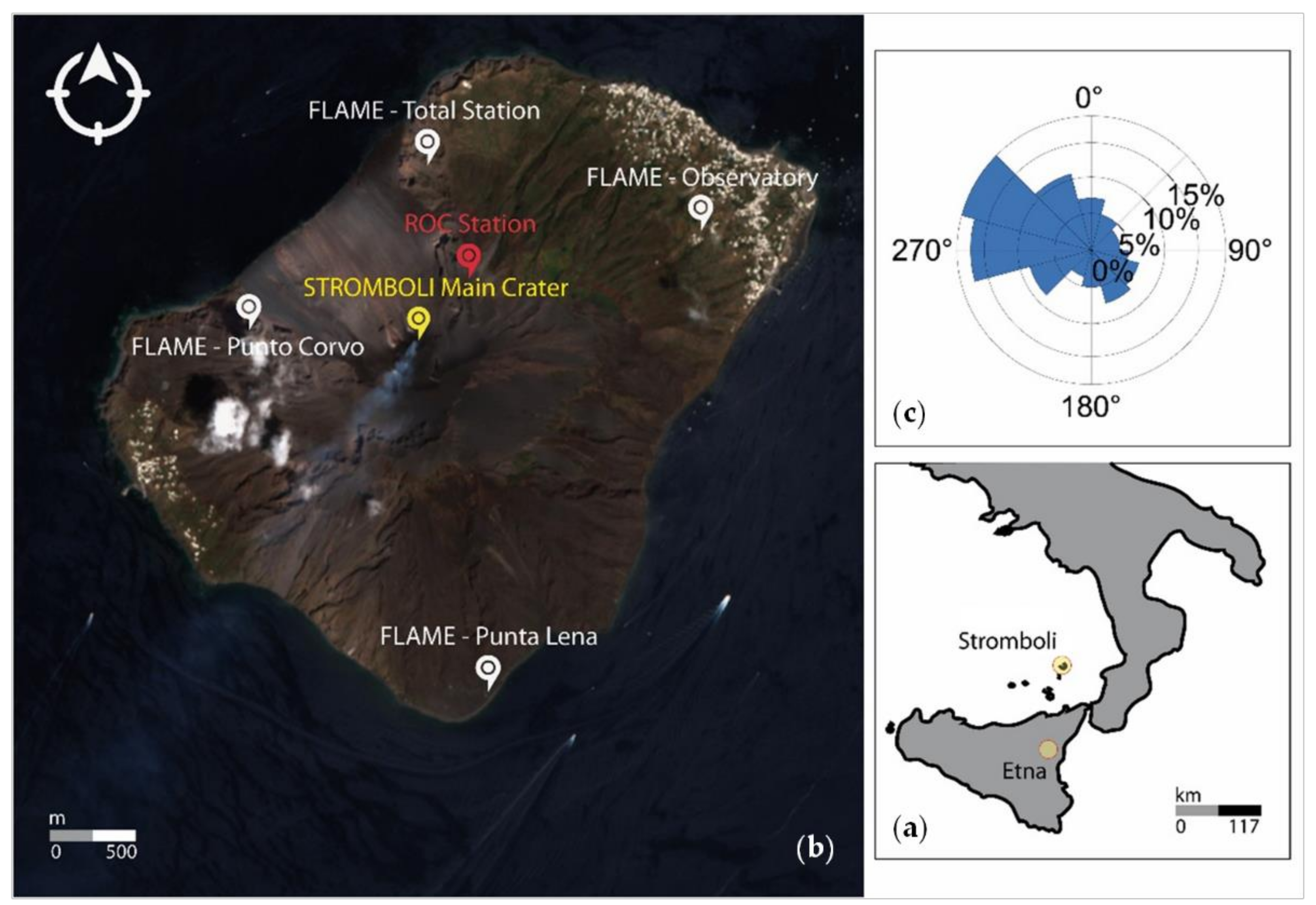

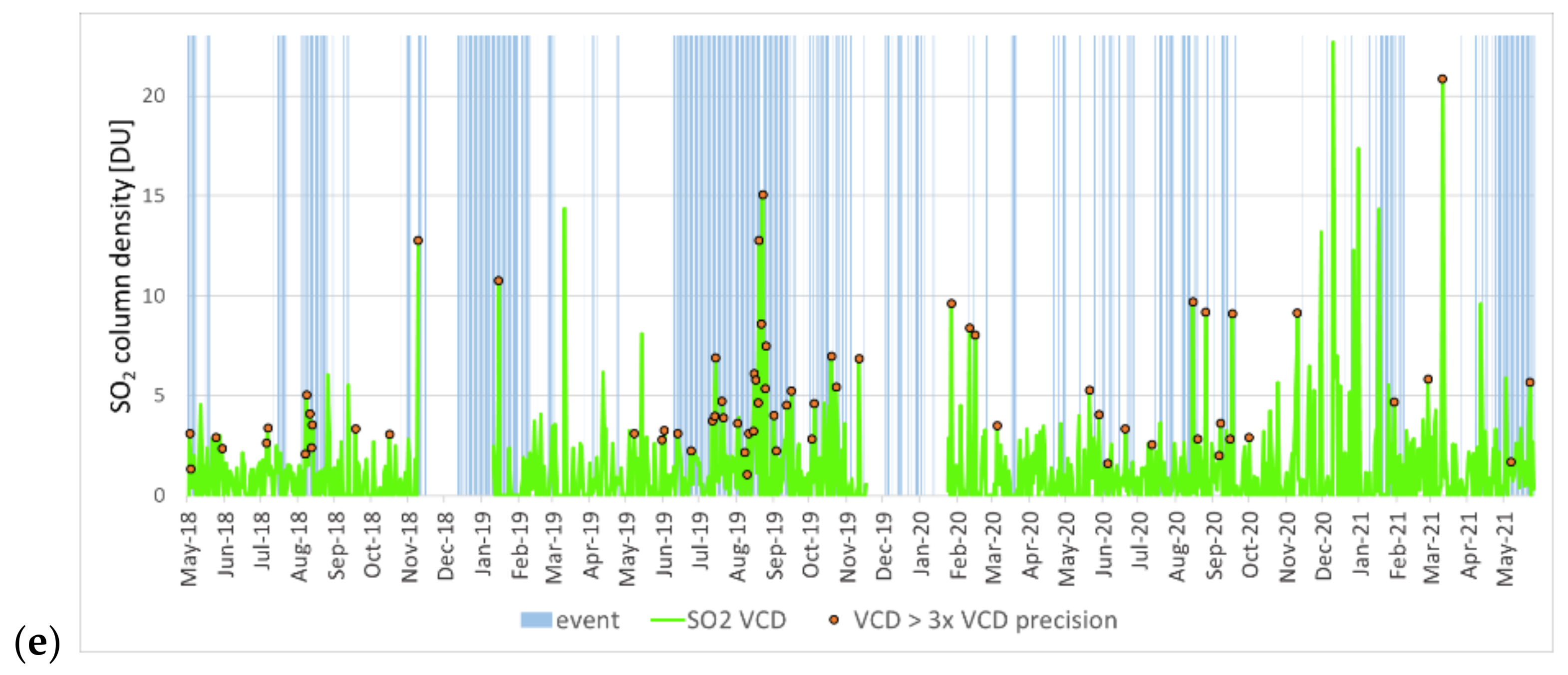
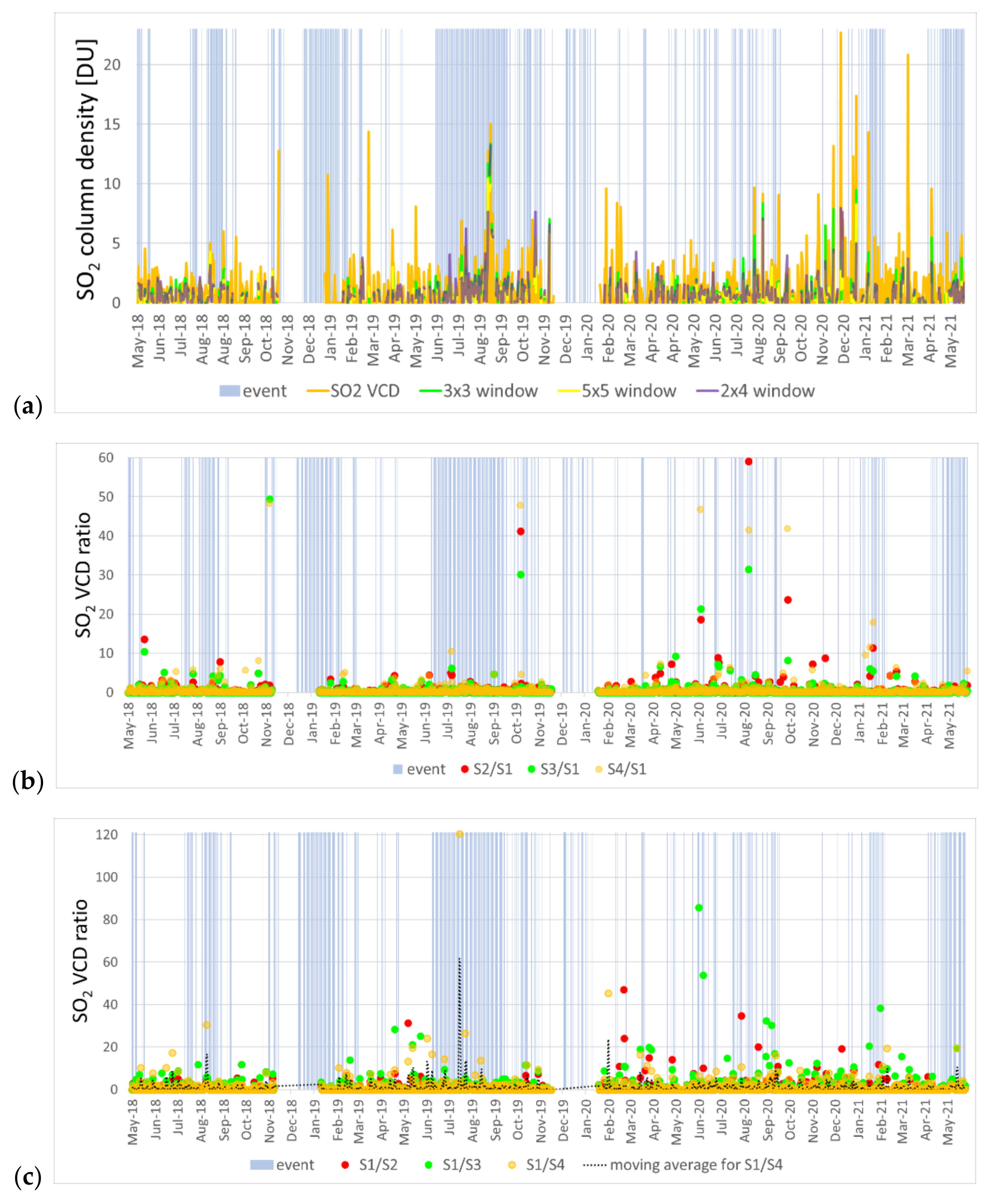
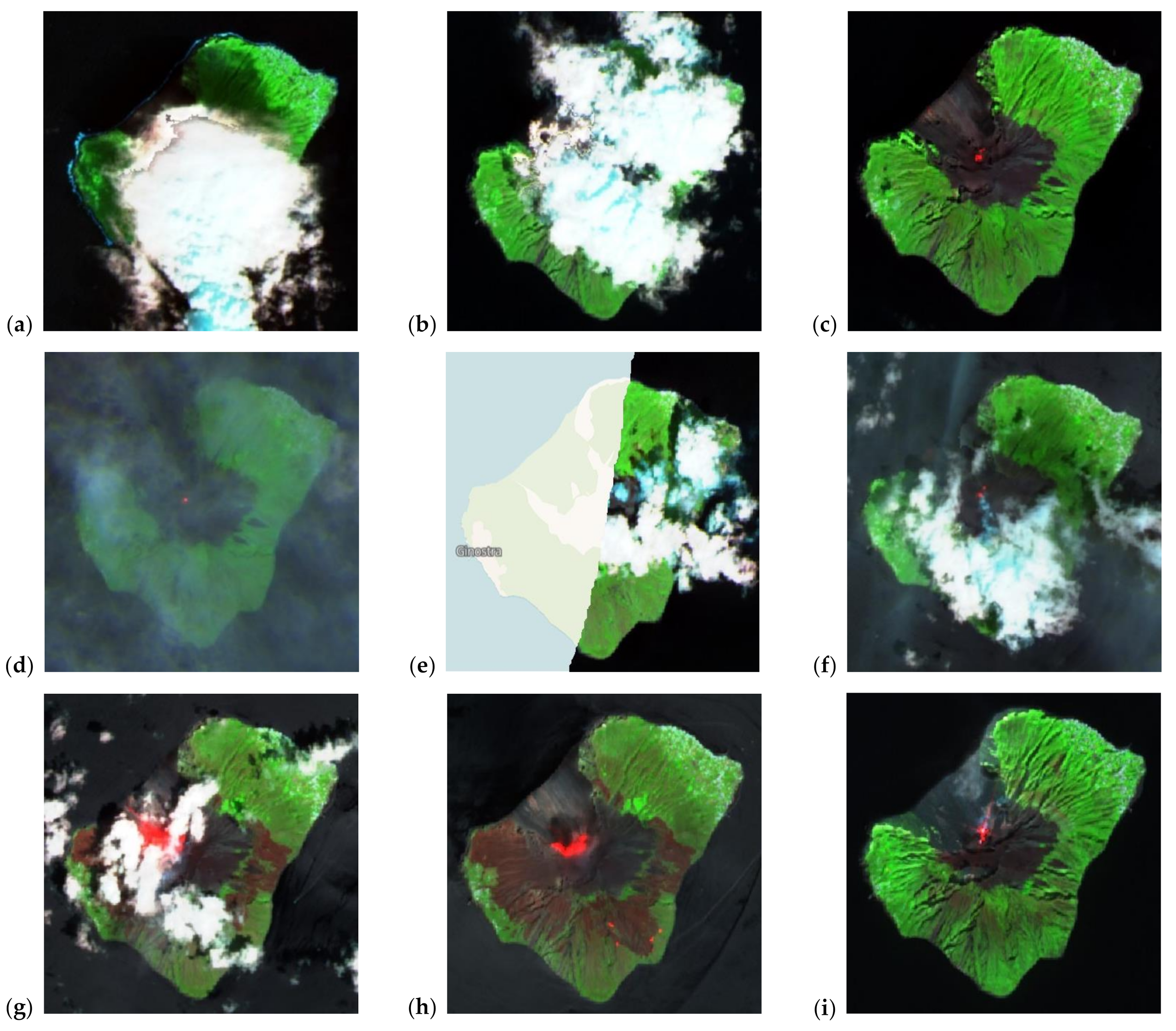
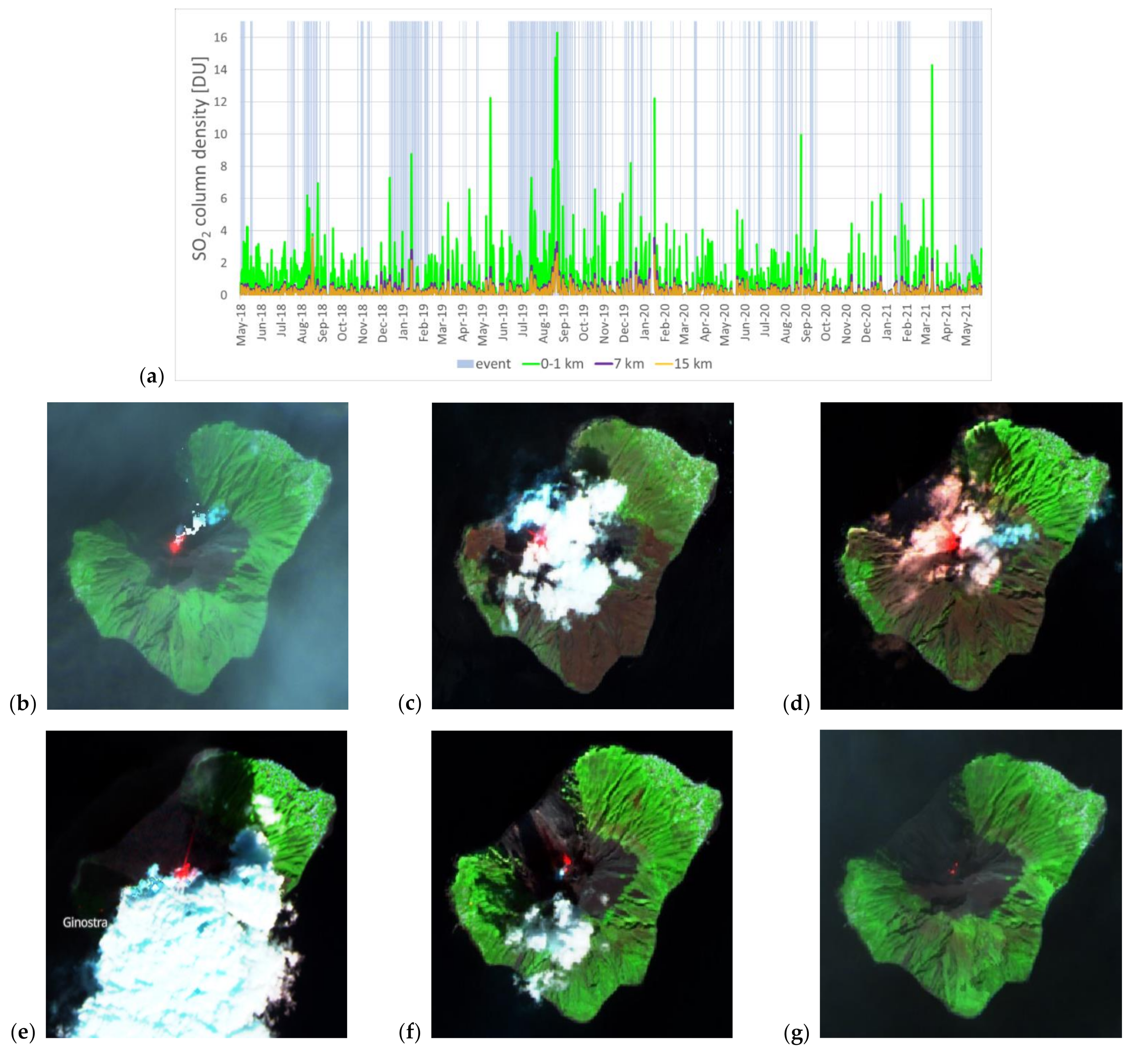
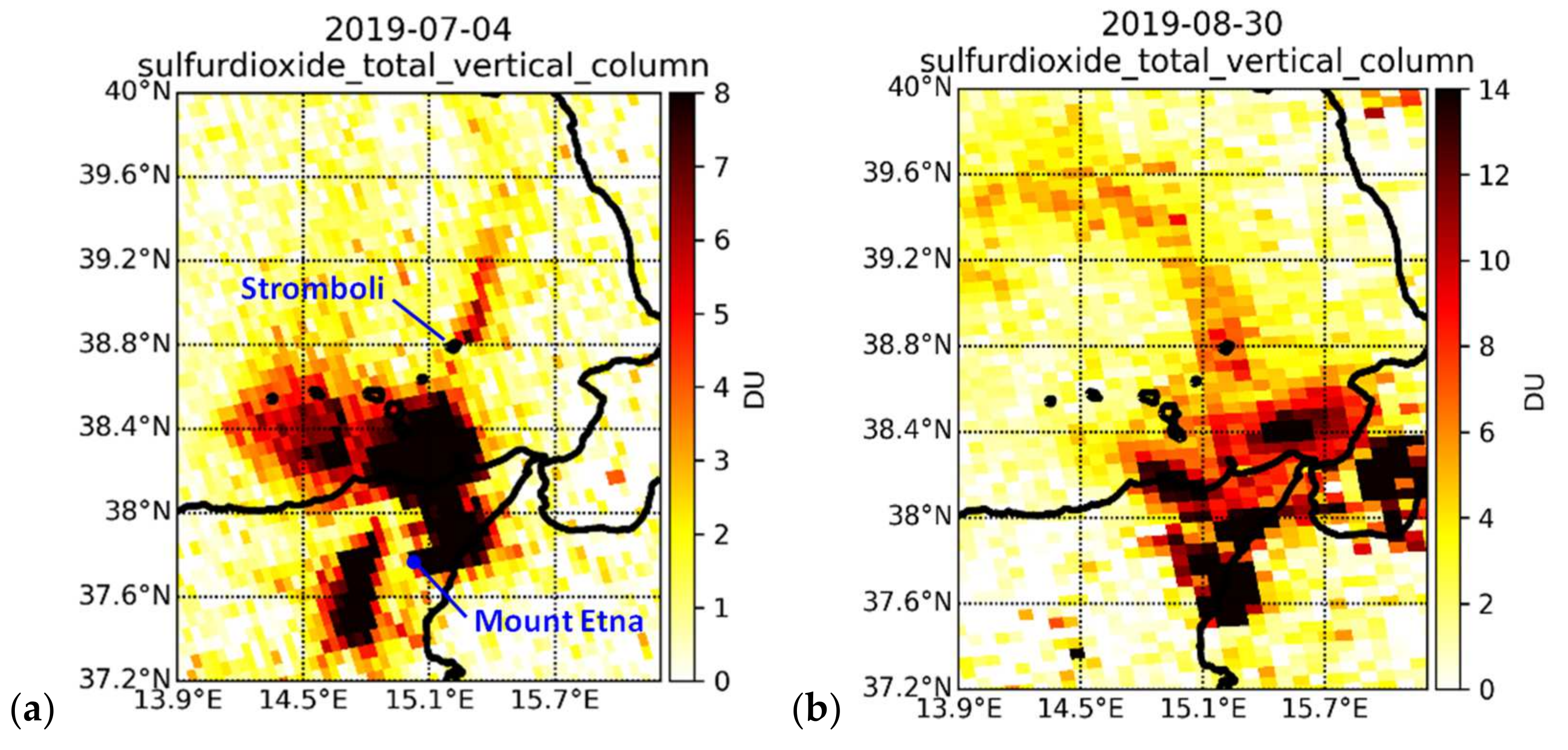

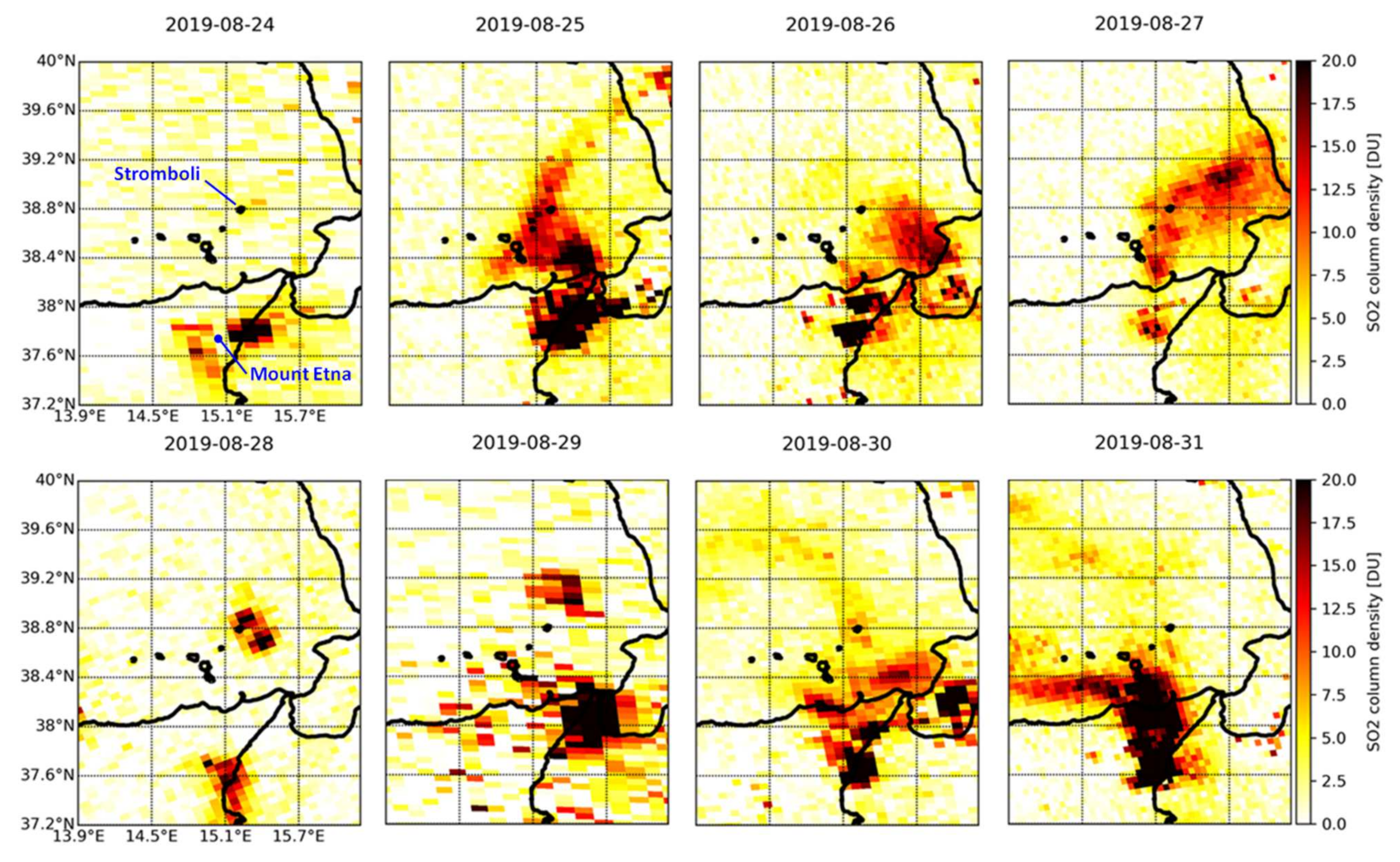

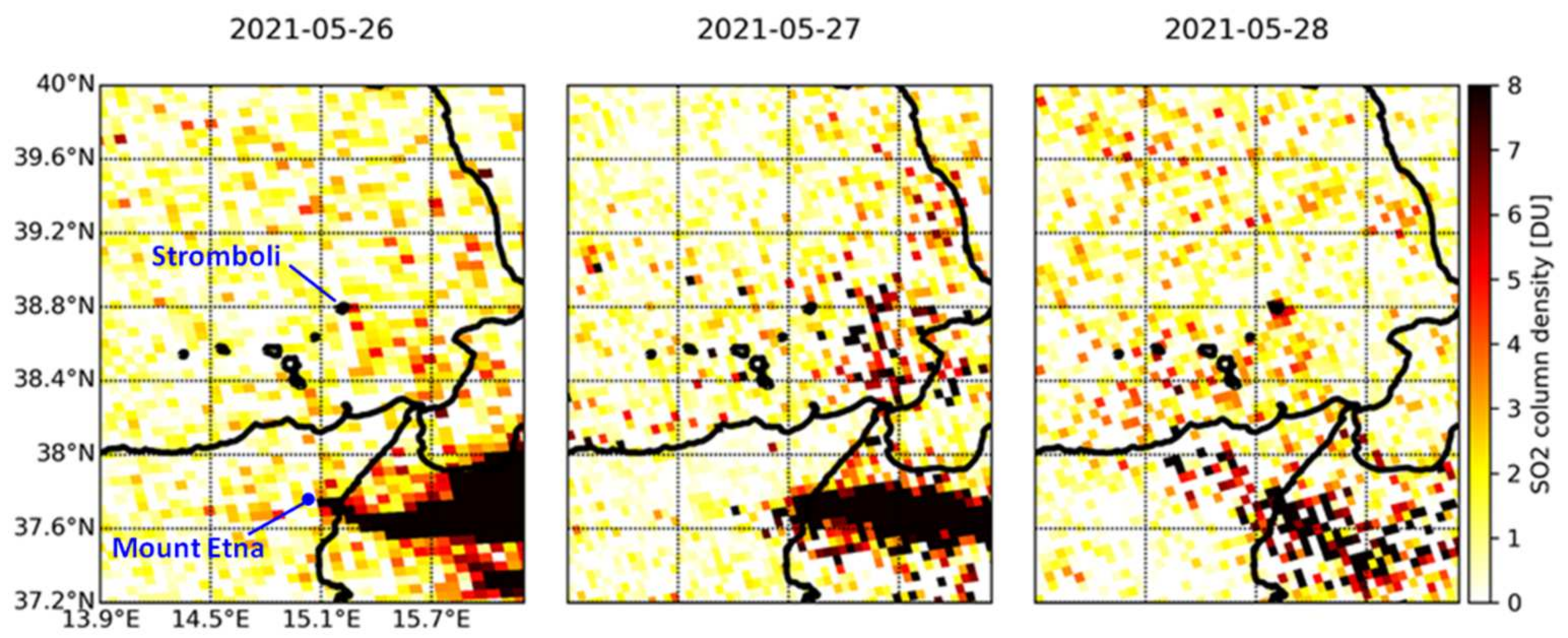
| Ratio | Condition | No. of Occurrences | SO2 Flux at ROC Station | |
|---|---|---|---|---|
| ≥70 t/d | <70 t/d | |||
| S1/S2 | 5 ≤ S1/S2 < 10 | 24 | 5 | 19 |
| S1/S2 ≥ 10 | 14 | 4 | 6 | |
| S1/S3 | 5 ≤ S1/S3 < 10 | 45 | 12 | 32 |
| S1/S3 ≥ 10 | 29 | 6 | 20 | |
| S1/S4 | 5 ≤ S1/S4 < 10 | 37 | 12 | 21 |
| S1/S4 ≥ 10 | 22 | 9 | 9 | |
Publisher’s Note: MDPI stays neutral with regard to jurisdictional claims in published maps and institutional affiliations. |
© 2021 by the authors. Licensee MDPI, Basel, Switzerland. This article is an open access article distributed under the terms and conditions of the Creative Commons Attribution (CC BY) license (https://creativecommons.org/licenses/by/4.0/).
Share and Cite
Cofano, A.; Cigna, F.; Santamaria Amato, L.; Siciliani de Cumis, M.; Tapete, D. Exploiting Sentinel-5P TROPOMI and Ground Sensor Data for the Detection of Volcanic SO2 Plumes and Activity in 2018–2021 at Stromboli, Italy. Sensors 2021, 21, 6991. https://doi.org/10.3390/s21216991
Cofano A, Cigna F, Santamaria Amato L, Siciliani de Cumis M, Tapete D. Exploiting Sentinel-5P TROPOMI and Ground Sensor Data for the Detection of Volcanic SO2 Plumes and Activity in 2018–2021 at Stromboli, Italy. Sensors. 2021; 21(21):6991. https://doi.org/10.3390/s21216991
Chicago/Turabian StyleCofano, Alessandra, Francesca Cigna, Luigi Santamaria Amato, Mario Siciliani de Cumis, and Deodato Tapete. 2021. "Exploiting Sentinel-5P TROPOMI and Ground Sensor Data for the Detection of Volcanic SO2 Plumes and Activity in 2018–2021 at Stromboli, Italy" Sensors 21, no. 21: 6991. https://doi.org/10.3390/s21216991
APA StyleCofano, A., Cigna, F., Santamaria Amato, L., Siciliani de Cumis, M., & Tapete, D. (2021). Exploiting Sentinel-5P TROPOMI and Ground Sensor Data for the Detection of Volcanic SO2 Plumes and Activity in 2018–2021 at Stromboli, Italy. Sensors, 21(21), 6991. https://doi.org/10.3390/s21216991









